**This post was updated on 18 August 2022 to include 2022 entry numbers in the charts.**
A-Levels results are out tomorrow, so this seems like a good time to think about which subjects are most popular.
We’ve written a few pieces recently about A-Level subject choice and trends over the last few years. But what about longer term trends? Are the choices students making now much different than they were when I went to school?
In this post, we’re going to explore the publicly available data published by JCQ to find out how subject choice has changed over the last twenty years.
Some omissions
As ever when we talk about subject choice, I’ll start with an apology that this post is restricted to A-Levels and doesn’t look at trends in BTECs and other KS5 qualifications. Unfortunately, equivalent data on those qualifications is not publicly available.
It would also be interesting to explore trends in the proportion of pupils choosing to study A-Levels as opposed to other options over the same period, but that’s not possible with the data we’ll be using here.
But on to what we can see.
An overview
Let’s take a look at how the total number of entries has changed since 2001.
Of course the number of A-Level entries isn’t the only thing that’s changed during this period, and I’ve marked the years of some noteworthy events on the chart below.
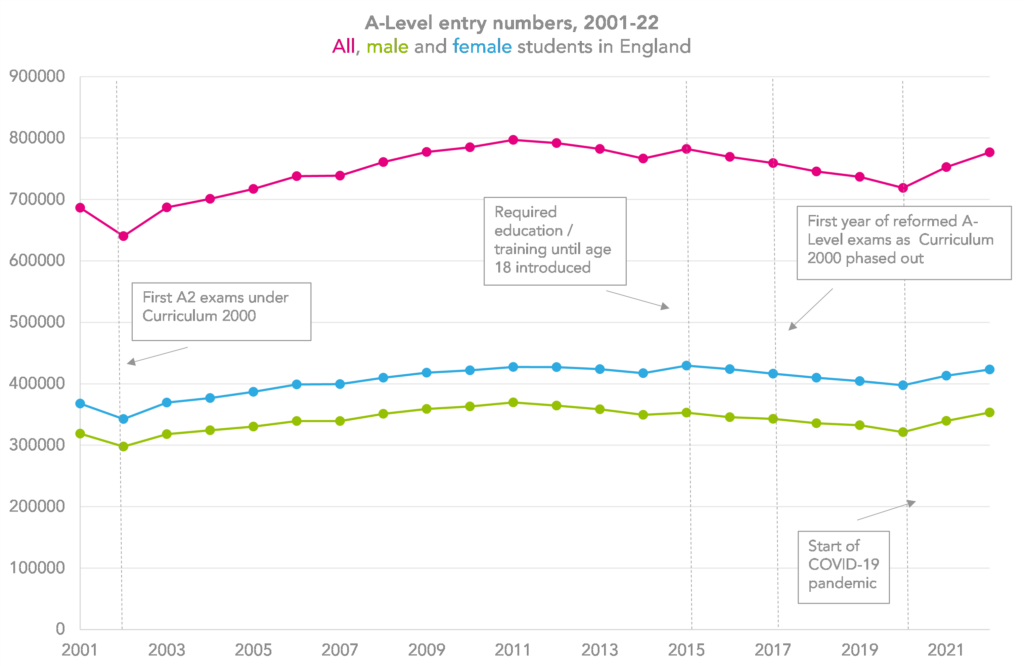
The overall number of entries increased from 686,486 in 2001 to 752,554, a 9.6% rise. At least some of this will be due to an increase in the population of young people.
Much of the increase in entries came about between 2002 and 2011, following the introduction of Curriculum 2000. Entries then decreased between 2011 and 2014.
In 2015, A-Level entries got a boost, but entry numbers went on to fall each year until 2020. 2021 saw another spike in entries, perhaps the result of fewer students failing to complete courses during the pandemic.
The top ten
Before we go on to discuss the fate of individual subjects since 2001 in more detail, let’s see a rundown of all entry numbers by year.
The chart below allows you to select a year and view the entry numbers, ordered by popularity, for all subjects that had at least 1,000 entries in 2021 and for which data is available for each year from 2001-21.[1]
Between 2001 and 2021, a group of eight subjects were in the top ten most popular subjects every year: English [2], maths, biology, chemistry, physics, art and design, psychology and history.
Now we’ll take a look at trends in entry numbers in more detail.
Maths and English
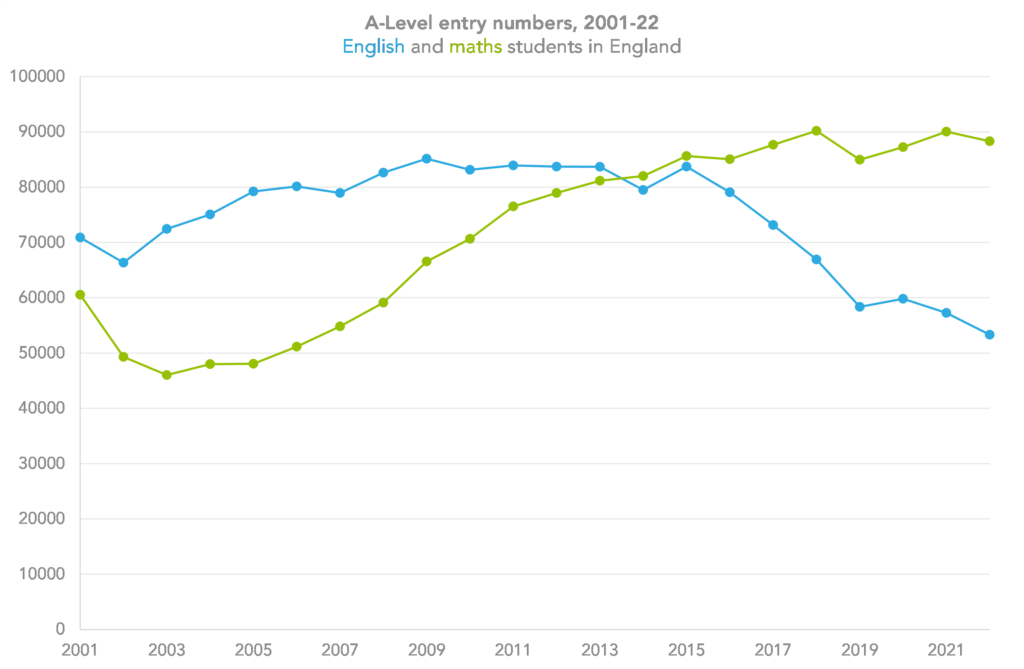
Maths displaced English as the most popular A-Level subject in 2014, and by 2021 had over 20,000 more entries than the next most popular subject, psychology. This reversal was caused not just by a sharp increase in maths entries from 2005 onwards, but by a sharp decrease in English entries from 2015-19.
Sciences
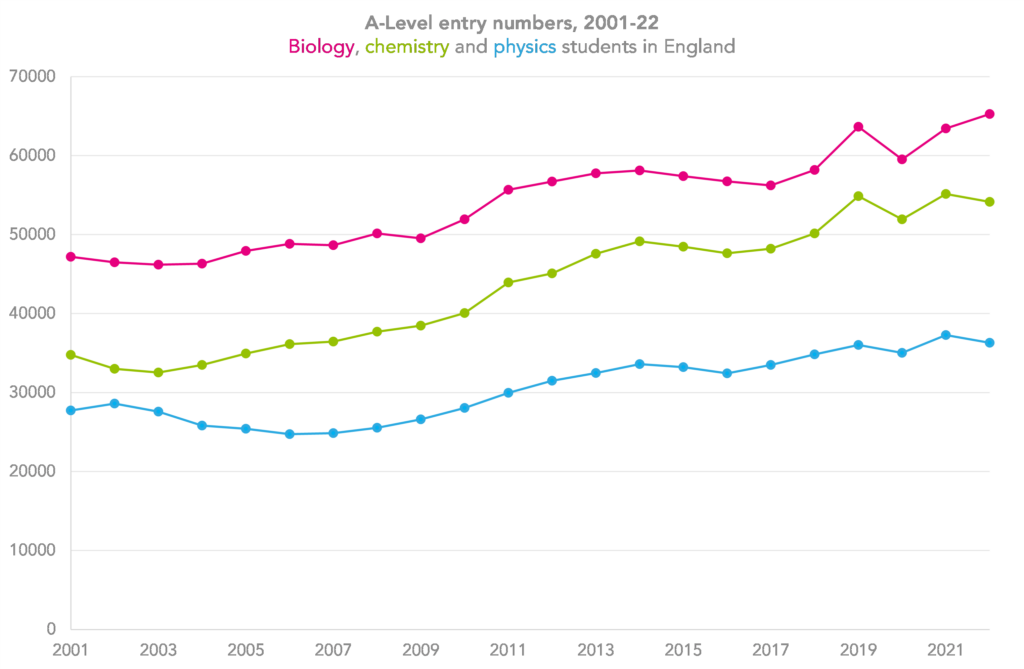
Broadly speaking, entries to science subjects have increased since 2001. Biology remains the most popular of the three, with chemistry and physics lagging behind. But chemistry has seen a particularly sharp increase in entries, and in 2021 had just 8,290 entries less than biology, compared to 12,409 in 2001.
Physics, unlike the other science subjects, saw a slump in entries between 2002 and 2006, before recovering with a broadly upward trend in entry numbers since 2007.
Humanities
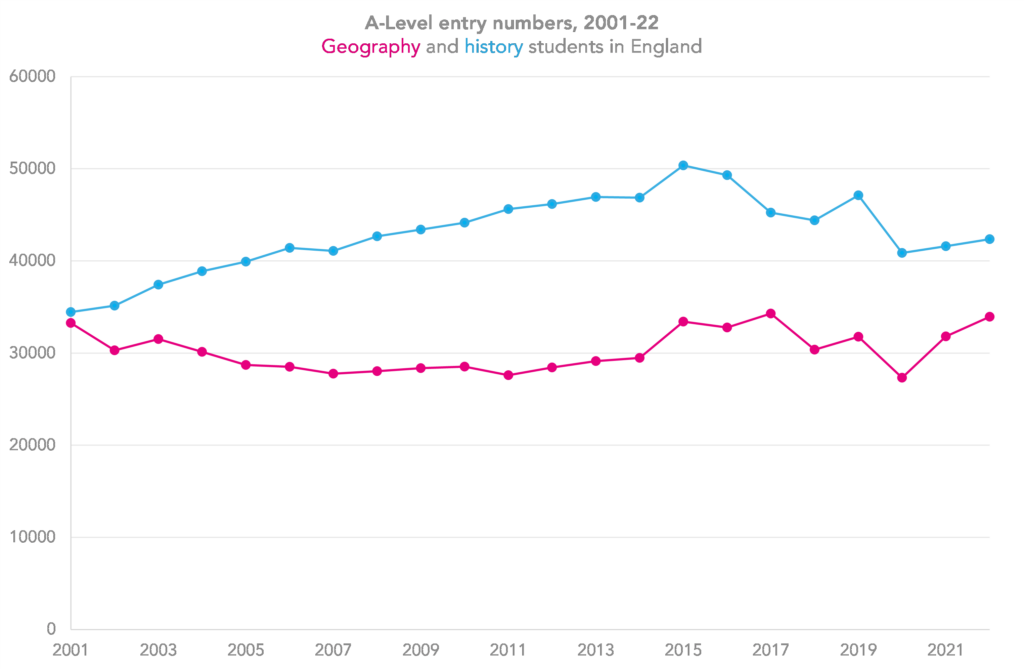
Entries to history and geography were almost equal in 2001, but while geography entries declined in the early 2000s, entries to history were on an upward trend until 2015. Since 2015, entries to both subjects have been somewhat erratic, but history remains the more popular of the two with nearly 10,000 more entries.
Modern foreign languages

In 2001, French was by far the most popular modern foreign language at A-Level, followed by German. But since 2019, Spanish has been the most popular option. Other modern languages have also increased in popularity since 2001, despite a steep fall in entries between 2018 and 2020.
Arts
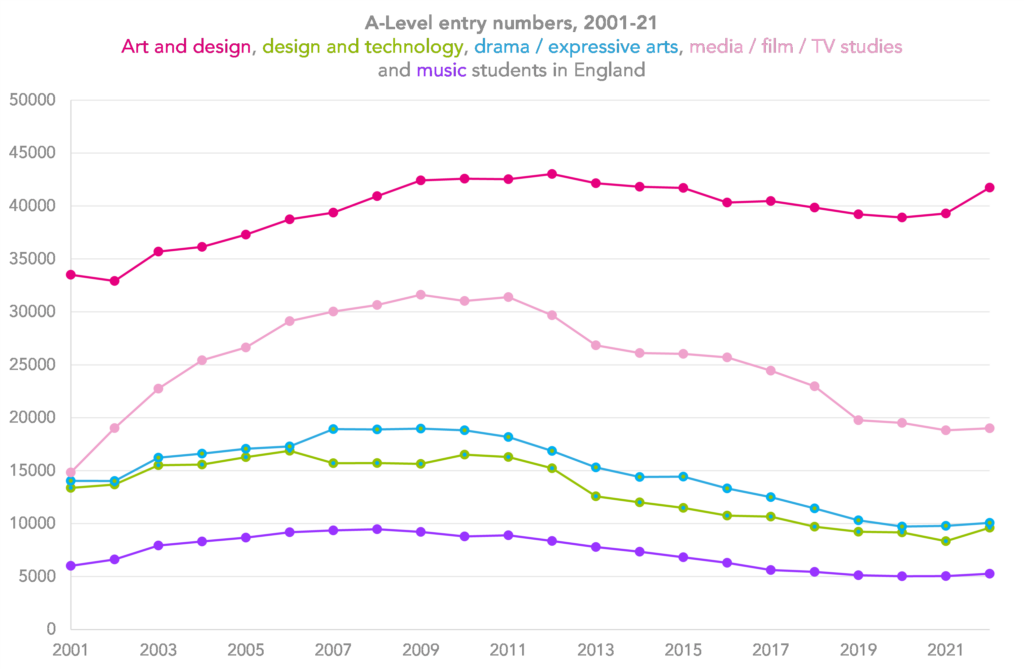
Entries to arts subjects generally increased between 2001 and 2009, but have been on a downward trend since around 2012. The introduction of Progress 8 and the English Baccalaureate may be at least partly to blame.
Entries to art and design have proved somewhat more robust than entries to other arts subjects; unlike D&T, music and drama / expressive arts, they remain well above the number in 2001.
Social sciences
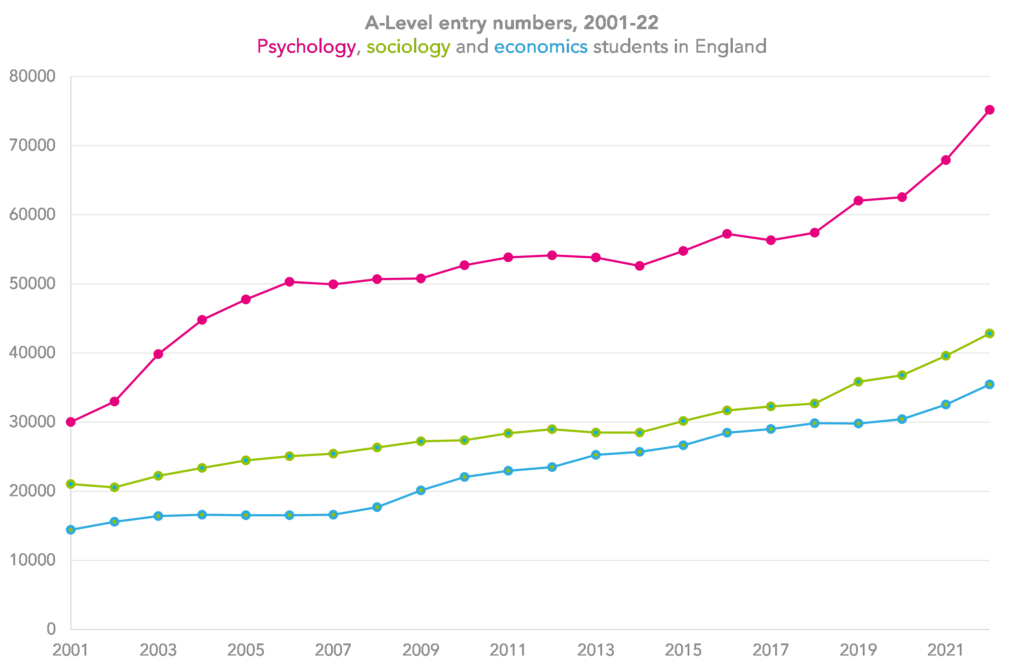
Entries to social science subjects increased between 2001 and 2021, with a particularly sharp in crease for psychology. In 2001, psychology was the ninth most popular A-Level choice, but in both 2020 and 2021 it was the second most popular – and the number one choice for female students.
Gender balance
Since 2001, great efforts have gone into improving gender balance in A-Level entries, particularly in the STEM subjects.
To get a sense of how much this has paid off, the chart below shows a snapshot of the percentage of entries to each A-Level subject who were female in 2001, 2011 and 2021. The dotted line indicates a 50/50 split between male and female students.
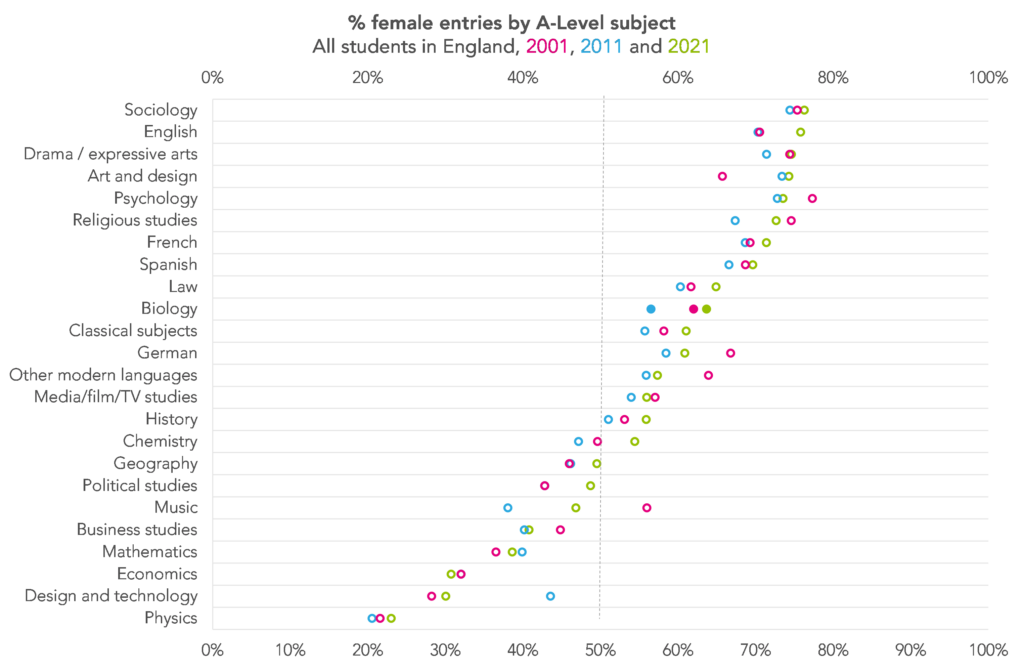
Some of the least balanced subjects, including physics, sociology and economics, showed very little change. And some, notably English and art and design, were even less balanced in 2021 than in 2001.
However, some subjects that had tended to be disproportionately male become more balanced, including maths, political studies, geography and chemistry. As did some subjects that had tended to be disproportionately female, including psychology, religious studies and German.
Choose your own adventure
Finally, for readers with a particular interest in one or more subjects, we’ve included interactive charts that allow you to select up to five subjects and compare trends in entry numbers and gender balance.
1. ‘Drama / expressive arts’ includes all entries recorded as expressive arts/drama (2001-06) and combined entries recorded as drama and performing / expressive arts (2007 onwards). ‘English’ includes all entries recorded as English (2001-16) and combined entries recorded as English literature, English language and English literature and language (2016 onwards). ‘Design and technology’ includes all entries recorded as technology subjects ( 2001-10) and as design and technology (2011 onwards).
2. As noted above, ‘English’ includes combined entries to English literature, English language and English language and literature.
Want to stay up-to-date with the latest research from FFT Education Datalab? Sign up to Datalab’s mailing list to get notifications about new blogposts, or to receive the team’s half-termly newsletter.






Hello. Why is accounting not included in these statistics? Are you able to inform.
Thanks.
Hi Jane. We’ve only included subjects that appear in the exam results published by JCQ for each year from 2001-22. JCQ don’t include data on some individual subjects that have low entry numbers – these are lumped together as ‘all other subjects’ – and accounting is presumably one of these. But DfE data shows that there were 2,186 entries to A-Levels in accounting and finance last year, down very slightly from 2,105 in 2019/20. The DfE data only includes a few years so we couldn’t use it for this post, but hope that’s of some interest anyway.